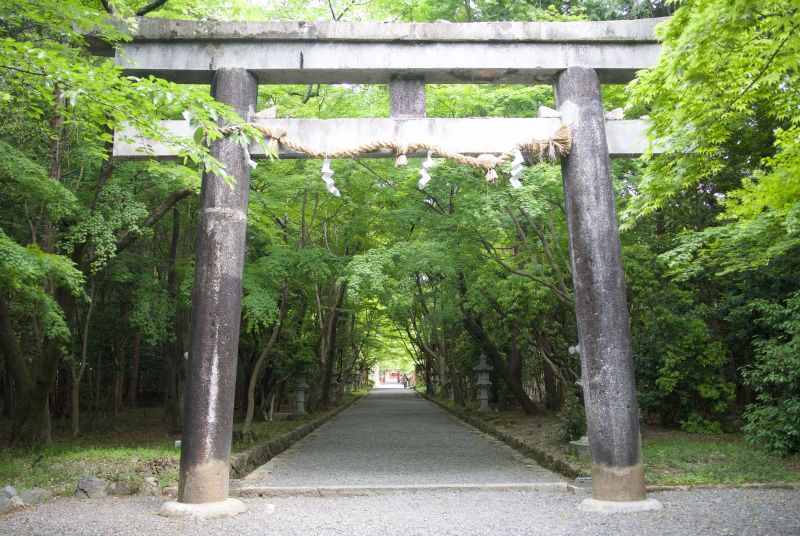
Entrance torii and approach to Oharano Shrine, reflecting its one-time importance
It’s on the outskirts of Kyoto. It’s in spacious woodland. It dates back to the eighth century and pre-Heian times. It’s little-known, but once it was counted amongst the top 22 shrines of Japan.
Oharano Shrine is closely associated with the powerful Fujiwara clan. It was set up by the dominant family at the time of the Nagaoka Capital (784-794), which preceded Heian-kyo (i.e. Kyoto). The area was said to be a favourite of Emperor Kammu (737-806), who hunted around the foothills, and the shrine later featured in such literary works as Tales of Ise and The Tale of Genji, while its pure spring water was celebrated in many a poem.
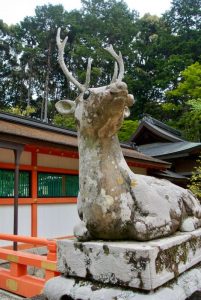
The deities here were installed from Kasuga Taisha, clan shrine of the Fujiwara whose symbol was the deer on which their kami rode.
Misfortune and an ‘angry spirit’ drove Emperor Kammu to abandon the Nagaoka capital, leading to the foundation of Heian-kyo in 794. The Fujiwara continued to keep up patronage of Oharano, even despite the establishment of Kyoto’s Yoshida Shrine in 859 as a new base for the clan.
The Fujiwara were descendants of the powerful Nakatomi clan, whose authority derived from having charge of court rituals and purification rites. Their ancestor, Ame no Koyane, was one of the five clan leaders who descended from heaven with Ninigi no mikoto in the so-called Tenson Korin.
One of the Fujiwara was the famous poet, Ariwara no Narihira (825–880), a courtier and grandson of Emperor Kammu. A renowned lady’s man, he was in love with Takako, the wife of Emperor Seiwa. Though he was banned from seeing her, he wrote the following poem on the occasion of her visit to Oharano (she was a distant relative of Narihira and as a Fujiwara was visiting her ujigami clan shrine).
おほはらやをしほの山もけふこそは神世のことも思ひいつらめ
Ohara ya Oshiho no yama mo kefukoso wa kamiyo no koto mo omohitsurameOharano and Oshio Mountain
on this day in particular
bring to mind
the Age of the Gods
The poem suggests that Takako’s visit conferred on the setting the majesty of a time when gods strode the earth, as portrayed in Japanese mythology. It was included in the first of the great imperial anthologies, Kokinwakashū (c.905).
There’s an interesting anecdote that goes with this poem, which is included in my Cultural History of Kyoto. According to tradition, Narihira lived on the site of the present-day temple of Jurin-ji, a fifteen minute walk away from Oharano Jinja. Like other aristocrats, he enjoyed salt making by boiling water, which resulted in steam rising into the sky. On the occasion of Takako’s visit, he added purple dye to the water thereby colouring the sky with evidence of his love for her.
Today Jurin-ji is keen to celebrate its link with the poet, and his supposed grave is prominently displayed while a site is marked out where his salt making could have taken place. Buddhist temple and Shinto shrine thus continue to be linked by poetry, even though the artificial separation of the Meiji Restoration in 1868 drew a line between them. Love conquers all!
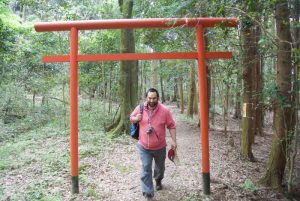
From Oharano Shrine to Hana Dera where Saigyo’s cherry tree stands is a pleasant woodland walk.
Close to Oharano Jinja, less than a ten minute walk away, is another temple with strong poetic connections. Hana Dera (Flower Temple) is the popular name of Shoji-ji, famed for its cherry blossom.
The wandering monk, Saigyo (1118 – 1190), stayed in a hut in the grounds as a young man when he was on retreat, and one of his poems describes the nuisance of noisy tourists coming to visit a flowering cherry tree at the temple – a sentiment with which contemporary Kyotoites might well sympathise! The poem blames the tree for attracting the crowds and forms the basis for a famous Noh play, Saigyo-zakura, written by Zeami (c. 1363 – c. 1443).
花見にと 群れつつ人の 来るのみぞ あたら桜の 咎(とが)にはありける
Hanami ni to mure tsutsu hito no kuru nomi zo atara sakura no toga ni wa arikeruThrongs of visitors
One after another
To view the cherry blossom –
It’s all the fault of the tree, regrettably,
For being so beautiful
The poem was included in Saigyo’s anthology, Gyokayoshu, with a heading by the poet that ran: ‘Composed on the occasion of a visit by people come to see my blossoms, just as I had planned to spend my time in peace.’
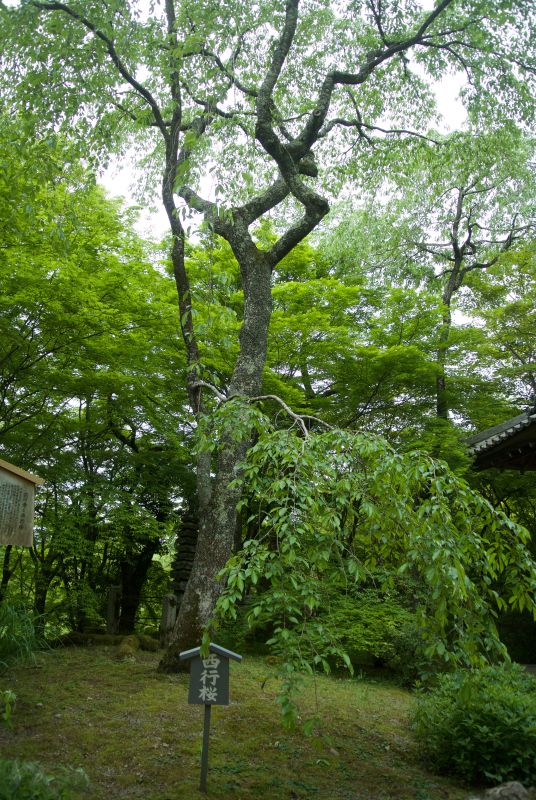
According to the temple, this is the third generation of a cherry tree that Saigyo himself planted in the grounds. The board calls it ‘Saigyo Zakura’, just like the Noh play.
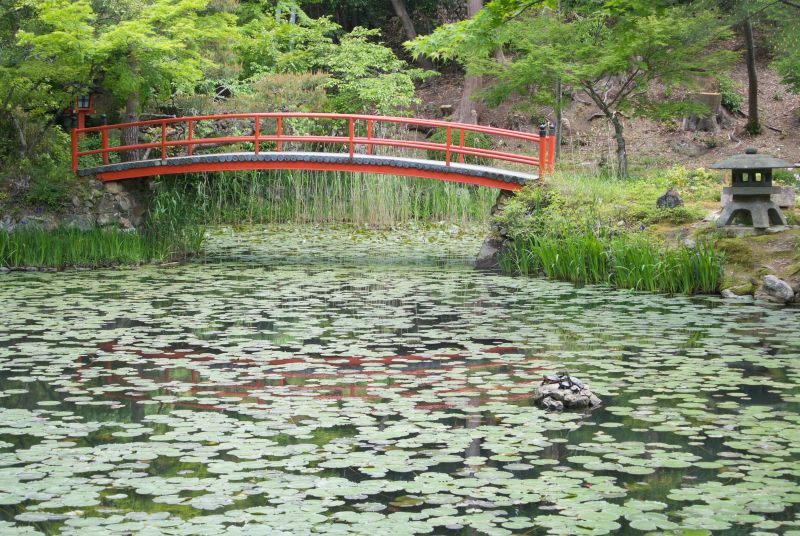
The lily pond is part of the spacious landscaped grounds at Oharano, evidence of the shrine’s former opulence
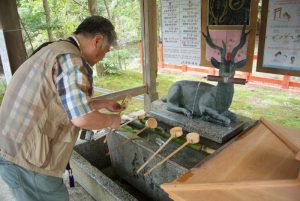
The deer motif which runs throughout the shrine is seen here at the water basin.
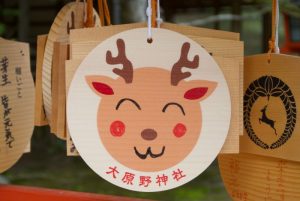
A cute version of the shrine’s totemic animal is found on the ’ema’ prayer boards.
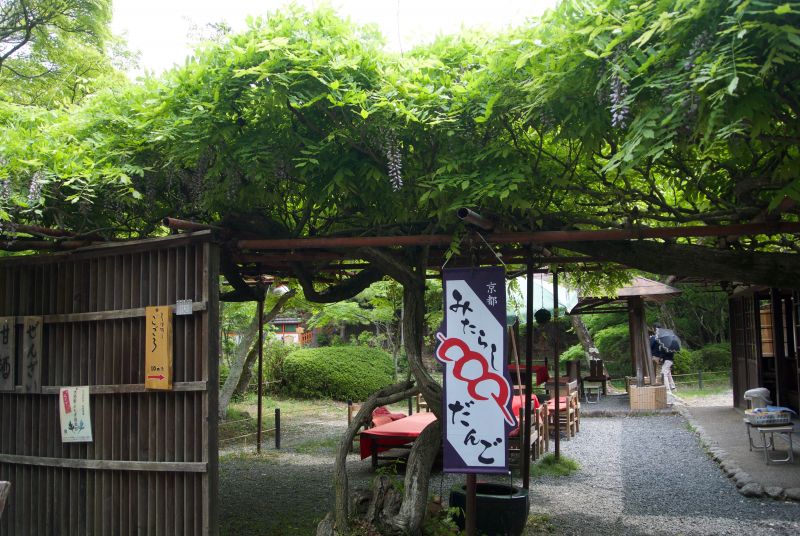
Another trademark of Fujiwara shrines is wisteria, which in Japanese is called ‘Fuji’.
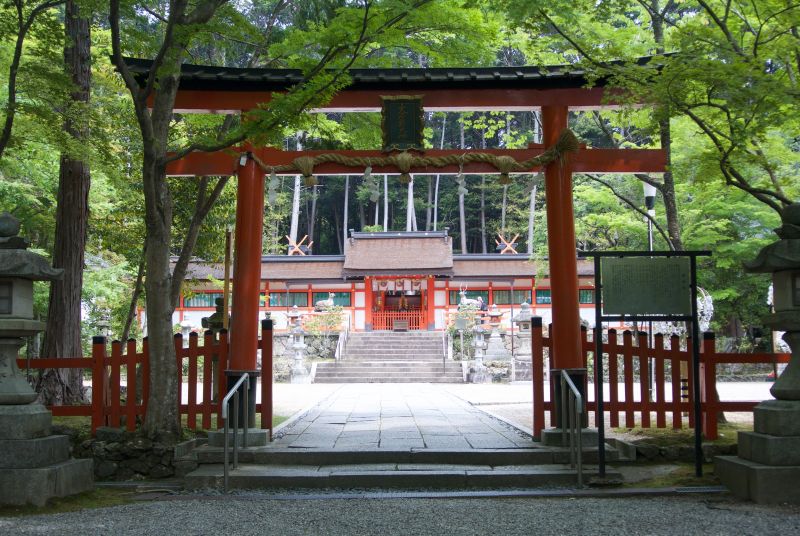
Even today the main compound impresses with its peace and stately nature. Unlike Saigyo’s poem, the shrine is now a place to get away from the downtown crowds of Kyoto – but please keep that secret!

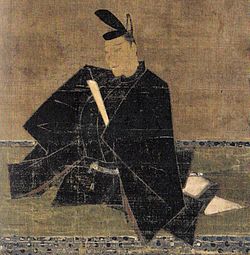 Japanese verse who also compiled Hyakunin Isshu – 100 Poems by !00 Poets. Like others of his time, he saw divine purpose in poetry and was careful to distinguish between Buddhist and Shinto verse.
Japanese verse who also compiled Hyakunin Isshu – 100 Poems by !00 Poets. Like others of his time, he saw divine purpose in poetry and was careful to distinguish between Buddhist and Shinto verse.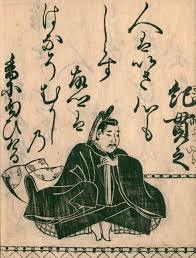 Tsurayuki was at a loss and summoned the shrine attendant to ask for advice. However, the attendant appeared to speak with the voice of the kami. ‘Since you did not realise there was a shrine, I should forgive you. But you are highly skilled in the way of poetry, so if you can display those skills as you pass in front of me I shall revive your horse. Thus speaks the god Aridoshi Myojin.’
Tsurayuki was at a loss and summoned the shrine attendant to ask for advice. However, the attendant appeared to speak with the voice of the kami. ‘Since you did not realise there was a shrine, I should forgive you. But you are highly skilled in the way of poetry, so if you can display those skills as you pass in front of me I shall revive your horse. Thus speaks the god Aridoshi Myojin.’